Elections in Europe
Becuwe Nicolas,
Emmanuel Rivière
-

Available versions :
EN
Becuwe Nicolas
Emmanuel Rivière
The next European elections will take place from 23rd to 26th May 2019 in the 27 Member States of the European Union. For the first time in its history, since 1979, they will not be taking place in the UK, which is due to leave the EU on 29th March next. Hence nearly 350 million voters will be called to ballot to elect 705 representatives to the European Parliament.
The issues at stake in these elections are multiple: turnout - on the decline since 1979; the emergence of so-called populist forces over the last five years, which hold an openly anti-European discourse; the emergence of new political players and even threats to the security of these elections as well as the dangers set by the spread of "fake news", will form the core of the debate.
Before discussing these themes, it seems appropriate to describe the methods of voting adopted in these European elections.
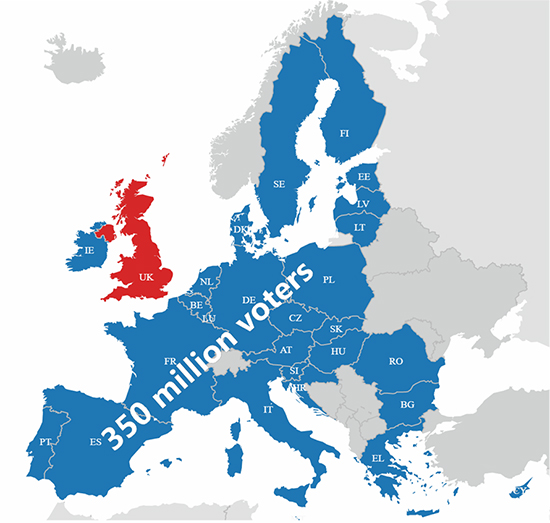
705 MEPs
1. Europeans are being invited to go and vote in May 2019 to elect 705 MEPs to the European Parliament. At present their number totals 751. It was decided to reduce this figure after the departure of the 73 British MEPs.
46 seats have been removed for the time being and reserved in the event of accession by a new Member State. We should recall that the proposal to introduce transnational lists to allocate these 46 seats was rejected by the European Parliament.
The other 27 have been distributed across 14 Member States to adjust their demographic representation. France and Spain are the two countries which have gained the most seats (+5) in virtue of this principle, resulting in a rise in their representation to 79 for France and 59 for Spain. The main delegation is still Germany which will appoint the same number of MEPs: 96. Italy and the Netherlands gain 3 seats, Ireland 2, and 9 Member States (Austria, Croatia,
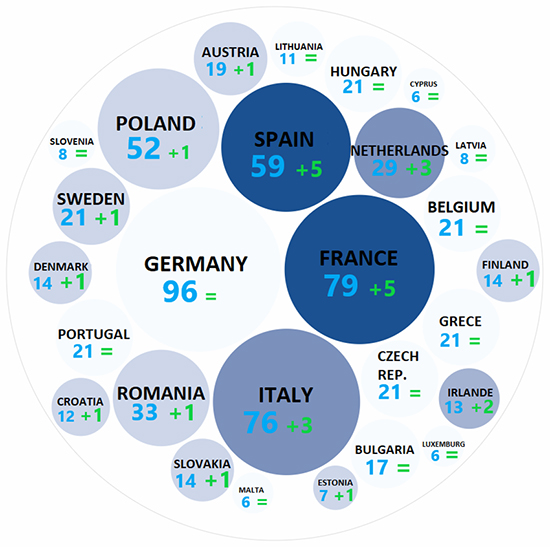
Denmark, Estonia, Finland, Poland, Romania, Slovakia and Sweden) each gain 1 seat each, still in virtue of demographic adjustments. It remains that proportional "degressivity" helps the smallest countries' representation via a stronger delegation than is their weight in the European population, notably due to the principle of a minimum delegation of 6 representatives per country (Cyprus, Luxembourg and Malta).
A sharply contrasting proportional vote in all Member States
2. The European treaties (decision of 2002) provides that these elections take place according to a proportional one round vote in all Member States of the European Union.
3. Despite this uniformity in voting method there are a number of differences which clearly impact results. Firstly, although in most countries there is a list vote, in Malta and Ireland, the single transferable voting system is applied. Hence, voters in these two countries can rank candidates in their order of preference.
4. The date of the European elections differs from one country to another. Some countries like the Netherlands will vote on Thursday 23rd May, whilst most countries will be voting on Sunday 26th May. The last voting stations will close in Italy at 23:00 (11pm).
5. In most Member States (18) voters can also express their preference for one candidate or another on the list of their choice. The preferential vote does not have any major effect on the results but leads to the emergence of charismatic political personalities.
6. The legal age of voting is 18 in all of the Member States, except for in Austria and Malta where it is set at 16 and in Greece at 17.
7. It is obligatory to vote in Belgium, Luxembourg and Greece. In Greece, this law is not really applied.
8. In most Member States voters are called to ballot for a national list. This is not the case in Ireland, Belgium and even Italy, which are divided into major regional constituencies. Until 2014 France was also divided into 8 regional constituencies. In 2018 it was decided to change over to one constituency, which may strengthen the idea that this is a first major national test. The choice of lead candidate of the various parties will especially be a strategic choice due to his/her exposure.
9. In certain Member States a minimum threshold is set in order to win a seat. The highest threshold is 5% (9 States), it is 4% in 3 States, 3% in Greece and 1.8% in Cyprus. This threshold does not favour "small" parties and is to the benefit of the larger ones.
In 2014 Germany decided to do away with the 5% threshold. This led to the entry into parliament of a significant number of small parties which are not present at national level. 12 other States have no threshold.
10. Beyond the election, the national context is vital in understanding differences. In Belgium for example federal elections will take place on the same day. In Spain there will also be regional elections. In France it will be a first electoral test for President Emmanuel Macron, and the first time for this election to be the first electoral round following a presidential and general election.
The issues at stake in this election
11. Electoral turnout is a major stake. Since 1979 the European Parliament has seen its role gain in importance and its power increase, whilst turnout has continually decreased. Of course, in 2014 the decline stabilised, since it dropped from 43% to 42.61%, but it is still an issue of major importance. The Parlemeter 2018, the Eurobarometer Survey 90.1 of the European Parliament observed mitigated awareness and interest.
The final voter turnout : a major issue
Voter turnout 1979-2014*

In an election with still low awareness
QA6 In your opinion, when will the next European Parliament elections be held here in (OUR COUNTRY)?
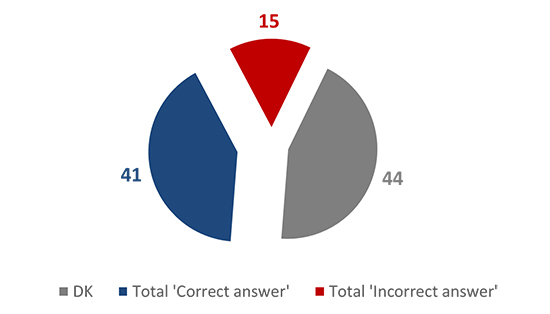
Hence in September 2018 nearly four Europeans in ten knew that there would be a European election in 2019. It has to be stressed however that this awareness has risen by about ten points since April 2018.
Just over half of those interviewed said they were interested in this election. During the previous elections this level was only reached in April 2014.
At this stage three Europeans in ten were certain to go and vote (31%). Nearly two Europeans in ten said that it was highly likely that they would go and vote (18%). Whilst the European citizens who were about to vote five years ago were still severely affected by the financial crisis and that of the sovereign debts, and focused their attention on economic and budgetary issues, today the causes of concern are different. When asked about the issues they wanted to see debated during the campaign Europeans have added to questions that are still present regarding economic growth and unemployment, subjects like immigration, terrorism and increasingly climate change. Of course, Europe itself features as a central issue, after a mandate marked by the exit of the UK (Brexit) the entry into office or within government coalitions of parties that are openly Eurosceptic and the sanction procedure (article 7 TEU) triggered against Hungary and Poland. The very visible problem of the Member States being unable to come to agreement over the migratory issue is a good illustration of this critical moment that the European Union is now experiencing. However, we must not summarise what we deem the overly generic term of populism as being purely a European issue. The electoral successes of parties, which have upset the traditional movements, find their explanation in claims or concerns over social issues or identity, the roots of which lie just as much nationally as they do globally.
The image and role of the European Parliament
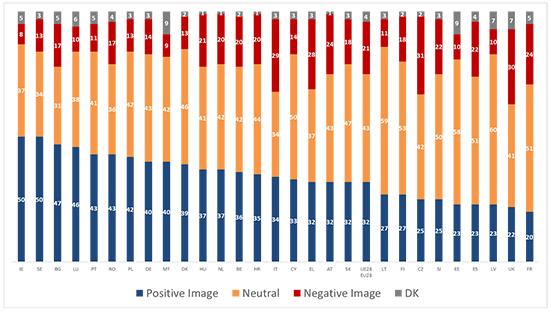
12. In a context of anti-establishment defiance, the European Parliament still enjoys a rather positive image. Around one third of Europeans have a positive image of it, against only 12% who see it negatively and a majority whose image is neutral (43%). Nearly half of Europeans hope however that the European Parliament will play a more important role in the future. In this regard the 2019 campaign must be the occasion for the work of communication and information. The particular nature and mode of voting in this election make it any easy launch pad for parties outside of the system and an outlet for occasional, categorical concerns. One of the stakes in the election will be to see how, in each Member State, national policy and European issues play together. The real nature of the election is often relegated to second place: appointing representatives to sit in a supranational Assembly,
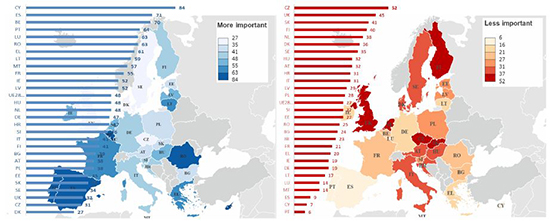
whose groups do not identically match the composition of the national parliaments. Local political rationale takes the upper hand, and attenuates the legibility of the Strasbourg institution and its role. It is not impossible to hope however that the weakening of national parties and the shared belief that some issues (notably immigration and the environment) can only be addressed at European level, will be an opportunity to strengthen the European dimension of the vote.
The political forces present: a populist wave?
13. After the European elections MEPS rally in European political groups to which their party is generally affiliated. To form a European political group a minimum of 25 MEPs is required from at least 7 national delegations. This is important because it makes the creation of a new group extremely complicated. In 2014 for example, the group "Europe of Nations and Freedom", which comprised the French Rassemblement National and the Italian Lega was only able to form because of a British MEP who had been excluded from the UKIP.
14. Political groups form on the occasion of the Constitutive Assembly which takes place just over a month after the elections, i.e. at the beginning of July 2019. At present there are 8 groups in the Parliament without counting the "non-affiliated" representatives. The European Parliament is - for the time being - organised around two major groups which have dominated the Parliament since its creation, the European People's Party (EPP), a centre-right group and the Progressive Alliance of Socialists and Democrats (S&D), a centre-left group. These two parties do not hold the absolute majority however, and vote within a coalition, even though they dominate debate. The EPP has 218 affiliated MEPs, i.e. around 30% of the MEPs in the European Parliament, the S&D have 187 MEPs, i.e. 20% of the European Parliament's seats. The other groups each have 5 and 10% of the seats.
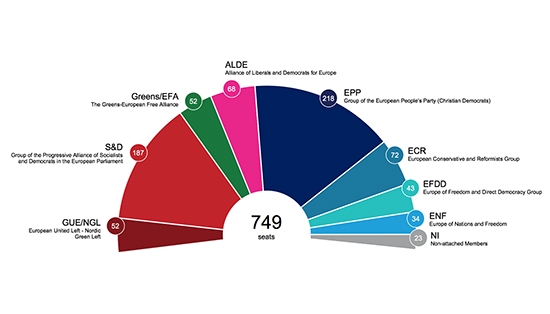
15. The main question regards the political future of the European Parliament and the European Union in the context of the rise of populist, eurosceptic, europhobic forces in national political arenas. This populist surge, which has led to governments that are openly hostile to the Union, as for example in Hungary with the Orban government, or more recently in Italy with the 5 Stars Movement-Lega coalition, is casting a shadow over the outcome of these elections.
The present forecasts
- if we take for example those undertaken by Politico on the basis of surveys collated by Kantar Public for the European Parliament, the first results could be like this:
-For the time being the EPP and S&D groups, although losing ground in comparison with 2014, are due to remain the two main political forces after these elections. They are credited with around 180 and 140 seats respectively. However, we have to be vigilant, because both groups may implode, notably the EPP due to the differences between its various members regarding the attitude to take towards the Hungarian government.
-At this stage the so-called "populist" parties are due to win around 150 seats, which, in all, will be the equivalent of the present number. The departure of the UK may weaken the European Conservative and Reformist (ECR) groups and the Europe of Freedom and Direct Democracy (EFDD) group. Moreover these 150 MEPs are for the time being spread across three different groups, which each have around 50 MEPs.
-The same applies to the emergence of a political force in the centre under the aegis of La République En Marche[1]. Steps have been taken by La République En Marche with many European parties. Some have responded positively like, Ciudadanos in Spain and the VVD party of Dutch Prime Minister Mark Rutte. It is hard to assess the potential of a group like this, which for the time being, seems to have a potential for around 100 MEPs, which is not enough to make it a dominant group in the European Parliament, but a significant group all the same. Moreover, there is already a centrist group, the Alliance of Liberals and Democrats for Europe (ALDE) led by former Belgian Prime Minister Guy Verhofstadt, and there is great confusion for the time being about the overall strategy of these centrist forces.
-What kind of score will the Greens achieve (Verts/ALE) in the European elections? For the time being they are only credited with around 45 seats, which is in line with their present number in the Parliament. The recent elections in the German Länder of Bavaria and Hessen, local elections in Belgium and the legislatives in Luxembourg, as well as the rise of concern about the environment in public opinion, might be beneficial to them, unless their arguments are taken up by other parties in the campaign.
-Finally, the far-left group (GUE/NGL) might also take advantage of a poisonous social climate in many Member States. Credited in forecasts with around 55 seats they might eat into the score of the Socialist and Democrat Alliance.
Present forecasts show a more complicated situation than the one which describes it as a fight between the "progressive" and "nationalist" forces. However, a step back should be taken regarding these initial forecasts, because they are mainly based on national voting intentions and the European elections do not yet feature high in public debate of most Member States.
The distribution of seats at the European Parliament : today and tomorrow?

16. Finally, after these elections the European Parliament will elect the President of the European Commission according to the election result. The Spitzenkandidaten system or 'lead candidate' of the European political parties was used in 2014 and will be used again in 2019. For the time being the candidates are German, Manfred Weber (CSU) for the EPP, Dutchman Frans Timmermans for the S&D, German Ska Keller and Dutchman Bas Eickhout for the Greens/EFA, Czech Jan Zahradil for the ECR. Apart from Frans Timmermans, the Commission's First President, the others are MEPs. They have a European profile, but are not necessarily known to the man in the street. In 2014 post-electoral studies revealed the limited impact of this process on turnout and the vote in the European elections. It is difficult to imagine at this stage, in 2019, that the election of a lead candidate will play a greater role due to the limited visibility of these candidates. This will depend on the orientation of the campaign and the weight of the European political parties.
The forecasts temper somewhat the scenario of a populist wave that is sometimes put forward. However, the progression of the sovereignist parties will quite probably disrupt the duopoly EPP-S&D, and, as a result, the automatic appointment of the lead candidate of the party that is best placed to take the presidency of the European Commission, if a coalition of three parties, at least, is necessary to form a majority. And this majority will not just have to distribute the positions but also it will have to send out a clear message about the Union's future, which seems to be reaching a crossroads, a message that will have to be set out in the campaign.
On condition that the next European elections are, via their global stakes (immigration, terrorism and the environment) and the declared wish on the part of many left and right-wing politicians to place the debate at European level, more truly European elections, rather than just an addition of national votes.
Publishing Director : Pascale Joannin
To go further
Asia and the Indo-Pacific
Pierrick Bouffaron
—
8 April 2025
Democracy and citizenship
Radovan Gura
—
25 March 2025
Strategy, Security and Defence
Stéphane Beemelmans
—
18 March 2025
Ukraine Russia
Alain Fabre
—
11 March 2025

The Letter
Schuman
European news of the week
Unique in its genre, with its 200,000 subscribers and its editions in 6 languages (French, English, German, Spanish, Polish and Ukrainian), it has brought to you, for 15 years, a summary of European news, more needed now than ever
Versions :




